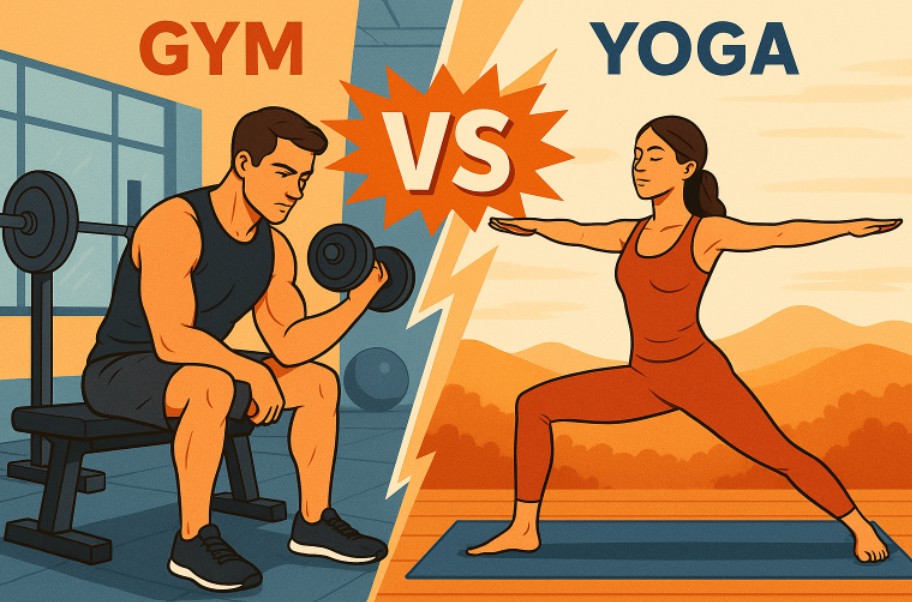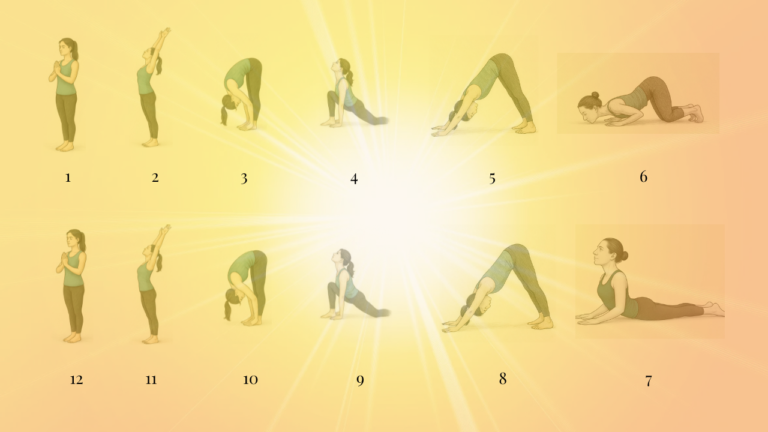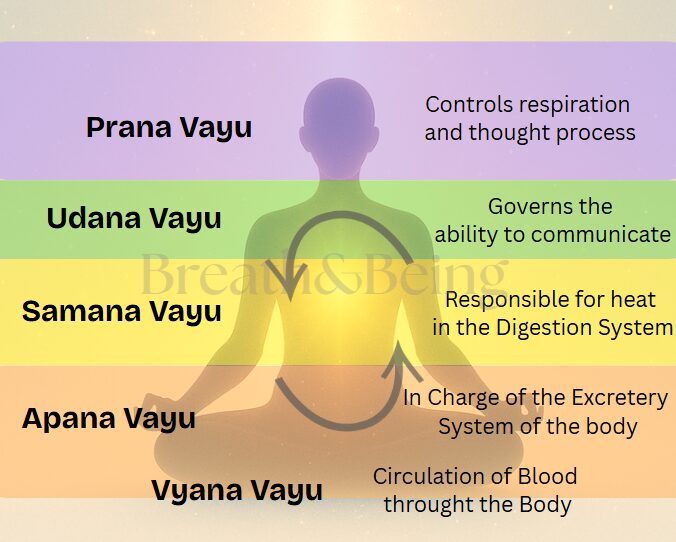Gym vs Yoga: Which Is Better for Your Body and Mind?
In the pursuit of physical fitness and mental well-being, there are two popular names that often emerge: gym and yoga. Each offers unique benefits and caters to different needs, goals, and lifestyles. But how do you decide which is better for you — gym workouts or yoga sessions? How do you decide whether the sweat from the gym or the stretches from yoga will make you feel balanced? Let’s explore the core differences, benefits, and considerations to help you make an informed choice.

1. Purpose and Focus
🏋️Gym: Building the Body Through Discipline and Intensity
The primary aim of gym workouts is to enhance physical performance and aesthetics. Gyms offer a structured environment designed for individuals who want to gain muscle mass, lose fat, or improve cardiovascular stamina. Whether you’re using machines, free weights, or doing bodyweight circuits, the gym encourages goal-oriented training.
- Weight training: Increases muscle size, strength, and tone.
- HIIT (High-Intensity Interval Training): Rapid, intense bursts of activity followed by rest, effective for fat loss and endurance.
- Functional fitness: Movements that mimic everyday activities, improving balance and mobility.
The gym setting promotes measurable progress — reps, sets, weights, and heart rate tracking — appealing to those who are driven by visible results and performance metrics.
🧘Yoga: Uniting Mind, Body, and Spirit
Yoga’s core purpose transcends physical fitness. It is a mind-body discipline with roots in ancient India, aimed at creating harmony between the body, breath, and consciousness. While it does strengthen the body, yoga also emphasizes self-awareness, stress management, and mental balance.
- Asanas (postures): Improve flexibility, core strength, and posture with controlled, mindful movement.
- Pranayama (breathing techniques): Help calm the nervous system, regulate energy, and improve respiratory efficiency.
- Meditation and mindfulness: Develop inner awareness, reduce anxiety, and enhance focus and emotional resilience.
- Spiritual grounding (optional in modern practice): Encourages self-reflection, acceptance, and connection.
Unlike the gym’s fast-paced, results-driven atmosphere, yoga invites you to slow down, listen to your body, and engage in present-moment awareness. It’s especially effective for those seeking balance, stress relief, and a non-competitive fitness approach. In Yoga the only performance metrics that helps you track your progress is how you feel.
2. Physical Benefits and Risks
While both gym training and yoga offer significant physical benefits, the way they enhance the body differs in intensity, mechanism, and outcome. But it also involves some risks in both
🏋️ Gym: Strength and High-Performance Conditioning
Gym-based workouts are tailored to transform the body through resistance and repetition. Whether your aim is to bulk up, tone down, or simply stay active, the gym provides the tools and structure to push your physical limits.
- Builds Muscle Mass and Core Strength
Through weightlifting and resistance training, you progressively overload muscles, stimulating growth. Core-focused exercises like planks, weighted crunches, and squats also develop stabilizing strength, essential for posture and injury prevention. - Improves Bone Density
Resistance exercises put healthy stress on bones, increasing bone mineral density. This makes the gym particularly beneficial in preventing conditions like osteoporosis, especially as you age. - Boosts Metabolism
Muscle burns more calories at rest than fat. By increasing lean muscle mass, gym workouts elevate your basal metabolic rate (BMR), meaning you burn more calories even when you’re not exercising. - Effective for Weight Loss and Muscle Toning
Cardio machines, HIIT circuits, and metabolic conditioning workouts are calorie-intensive, helping reduce body fat. Paired with weight training, they lead to defined, toned musculature over time.
🧘 Yoga: Flexibility, Functional Strength, and Longevity
Yoga might seem gentle on the surface, but it offers a deep, transformative impact on physical health — especially when practiced consistently. It strengthens the body in more subtle ways and is ideal for people of all ages and fitness levels.
- Enhances Flexibility and Balance
Regular yoga gradually increases your range of motion, releasing tension in tight muscles and improving coordination. Poses like Trikonasana, Natarajan, and Tree Pose (Vrikshasana) enhance balance, which is critical for long-term mobility and injury prevention. - Strengthens Muscles Using Body Weight
Yoga doesn’t rely on external weights, but bodyweight resistance in poses like Chaturanga, Warrior, and Boat pose can build surprising strength — especially in the core, legs, and upper body. - Improves Posture and Joint Health
Yoga emphasizes alignment and awareness, which corrects postural habits that cause back and neck pain. It also nourishes the joints through gentle movement and stretching, helping maintain joint function and reduce stiffness. - Supports Gentle Weight Loss Over Time
Though not as intense as the gym, yoga supports fat loss by lowering cortisol levels, improving digestion, and increasing mindfulness around eating. Combined with healthier lifestyle choices, it leads to sustainable, long-term changes.
3. Mental and Emotional Benefits
Physical fitness isn’t just about the body — it’s deeply tied to how we feel, think, and process the world around us. Both the gym and yoga offer powerful benefits for mental and emotional well-being, but they do so in very different ways. Let’s explore how each approach impacts the mind.
🏋️ Gym: Motivation, Confidence, and Mental Grit
The gym is more than just a place to work out — it’s often a mental battleground where you build discipline, willpower, and self-belief. Regular gym-goers often describe feeling energized, accomplished, and motivated after a workout session.
- Releases Endorphins to Combat Stress and Boost Mood
Physical exertion stimulates the release of endorphins, known as the “feel-good” hormones. This natural high can relieve stress, combat anxiety, and lift your mood, especially after intense cardio or resistance training. - Increases Discipline and Goal-Setting Skills
Gym routines require commitment and consistency. Setting targets — whether it’s lifting heavier weights, running longer, or completing a training program — fosters a goal-oriented mindset. This discipline often carries over into other areas of life, like work or academics. - Creates a Sense of Accomplishment and Control
Sticking to a gym schedule can give you a feeling of control and achievement, particularly during stressful or uncertain times. It offers a productive outlet for emotional energy, building confidence through tangible progress. - Limitations:
While uplifting and empowering, gym workouts tend to focus on external results and physical performance. They may not address deeper emotional needs such as unresolved stress, inner calm, or mental overactivity unless paired with practices like mindfulness or meditation.
🧘 Yoga: Mindfulness, Healing, and Emotional Balance
Yoga is widely recognized as a powerful tool for mental clarity and emotional resilience. By focusing on the breath, body awareness, and present-moment experience, yoga promotes calmness, acceptance, and inner peace.
Mental and Emotional Benefits of Yoga Practice:
- Reduces Anxiety, Stress, and Depression
Through mindful breathing (pranayama) and gentle movement, yoga helps calm the nervous system. Regular practice reduces cortisol (the stress hormone), lowers heart rate, and creates a sense of safety and groundedness. - Improves Focus and Emotional Resilience
Meditation and stillness in yoga enhance mental clarity and attention span. Over time, this leads to better emotional regulation, allowing practitioners to respond thoughtfully to challenges instead of reacting impulsively. - Long-Term Impact:
Yoga is especially beneficial for those dealing with burnout, chronic stress, or emotional fatigue. It teaches tools to cope with life’s ups and downs with grace and stillness, not just during practice but in everyday living.
4. Injury Risk and Recovery
Both gym training and yoga can contribute to better overall physical health — but they carry different levels of injury risk and play distinct roles in recovery and rehabilitation. Understanding these differences can help you choose the right practice based on your body’s current condition, fitness experience, and injury history.
🏋️ Gym: Higher Impact, Greater Risk Without Proper Form
Gym workouts — especially those involving heavy weights, fast-paced circuits, or machines can deliver rapid physical gains. However, they also come with a higher potential for injury when not performed with proper form or appropriate progression.
Injury Risk Factors in Gym Training:
- Poor Technique
Lifting weights or using equipment incorrectly can lead to strains, sprains, and joint issues. Common injuries include lower back pain, rotator cuff strains, and knee injuries from poor squatting form. - Overtraining and Burnout
High-intensity routines or insufficient rest between sessions can cause muscle fatigue, chronic soreness, or even exercise-induced burnout. Without proper recovery, overuse injuries like tendonitis can occur. - Neglecting Warm-up/Cool-down
Skipping warm-ups increases the chance of acute injuries, while omitting cooldowns (like stretching) can lead to muscle stiffness or delayed recovery. Proper pre- and post-workout care is crucial for injury prevention.
Despite these risks, the gym can still support injury rehabilitation and muscle reconditioning, especially under professional supervision, such as with a physical therapist or personal trainer.
🧘 Yoga: Gentle Healing and Safer Movement Patterns
Yoga is widely praised for being low-impact, adaptable, and mindful — making it particularly suitable for people recovering from injuries or dealing with chronic pain. While not entirely risk-free, it carries a significantly lower injury rate, especially in slow-paced or guided sessions.
Recovery and Injury Prevention Through Yoga:
- Low Impact, High Awareness
Yoga’s emphasis on body awareness, breath, and slow movement reduces the likelihood of sudden injury. It’s especially helpful for individuals with joint concerns, arthritis, or limited mobility. - Supports Injury Rehabilitation
Therapeutic yoga can aid in the healing of old injuries, restore range of motion, and gently rebuild strength without aggressive force. It’s often used in rehabilitation settings for back pain, shoulder tightness, and post-surgical recovery. - Encourages Mindful Progression
Since yoga teaches listening to the body’s limits, practitioners learn to avoid pushing into pain or discomfort. This reduces risk and promotes sustainable, long-term movement habits.
That said, advanced poses or overextension in flexibility-focused classes can still lead to strains — especially in the hamstrings, lower back, or wrists. As with any discipline, proper instruction and self-awareness are key.
5. Lifestyle, Affordability and Accessibility
When deciding between gym workouts and yoga, it’s essential to consider not just physical outcomes, but also how each fits into your daily life, schedule, budget, and environment. Some people thrive in a structured gym setting, while others prefer the flexibility and freedom of yoga. Here’s a closer look at how each practice aligns with modern lifestyles.
🏋️ Gym: Structured, Equipment-Heavy, and Costly
Gyms offer an organized and focused environment tailored to physical transformation and performance. However, this structured experience often comes with financial, logistical, and time-related considerations.
- Requires Equipment and Often a Membership
Most gym routines depend on specialized machines, free weights, or equipment not commonly found at home. Memberships can range from affordable monthly fees to premium rates, especially for personal-training facilities. - Time-Dependent and Location-Based
Gym workouts typically involve travel time, and peak hours can be crowded. For those with tight schedules, getting to the gym may become a barrier to consistency. - Less Suitable for People with Joint or Stress Issues
High-intensity routines or high-impact cardio may not be ideal for individuals with chronic pain, injuries, or stress-related fatigue. Some may also find the gym atmosphere intimidating or overstimulating. - Performance-Oriented Culture
Gym culture can be highly motivational, but it may also pressure some individuals to compare progress, chase numbers, or overtrain, which isn’t always ideal for holistic wellness.
🧘 Yoga: Flexible, Affordable, and Universally Inclusive
Yoga shines in its simplicity, accessibility, and low-cost approach. All you really need is your body, your breath, and (ideally) a mat. Whether practiced at home, in a studio, or outdoors, yoga can easily be adapted to fit any lifestyle.
- Minimal Equipment, Low-Cost or Free Options
A yoga mat and comfortable clothes are often enough. Many classes are available online for free, and in-person sessions range from donation-based to premium studio memberships, making yoga widely accessible at all price points. - Time-Flexible and Portable
Yoga can be practiced anywhere, anytime — in your living room, at the park, or during a work break. Sessions can last 5 minutes or 90, offering unmatched flexibility for busy schedules. - Beginner-Friendly and Non-Judgmental
Yoga welcomes all ages, body types, and abilities, and instructors often provide modifications for poses. This inclusive approach makes it a great choice for seniors, people with limited mobility, or those recovering from injury.
6. Nutrition: Fueling the Body for Different Goals
Your physical activity style if often complemented by your nutritional intake. While both gym training and yoga benefit from balanced, whole-food nutrition, their dietary focus, caloric demands, and timing can differ significantly. Let’s break down how each approach influences (and is influenced by) what you eat.

🏋️ Gym: High-Energy, Performance-Focused Nutrition
Gym-goers typically follow a more structured and goal-oriented nutritional regimen, designed to optimize muscle growth, energy output, or fat loss. Nutrition often becomes an integral part of the gym lifestyle — as important as the workout itself.
- High-Protein Intake for Muscle Repair and Growth
Protein shakes, lean meats, tofu, and legumes are staples to support muscle recovery and hypertrophy. - Carbohydrates for Energy
Complex carbs (like oats, brown rice, sweet potatoes) provide fuel for intense workouts and replenish glycogen stores post-exercise. - Timing and Macronutrient Ratios Matter
Many gym-goers eat strategically before and after workouts, focusing on pre-workout fueling and post-workout recovery meals. - Supplements Are Common
Whey protein, BCAAs, creatine, and pre-workout drinks are often used to enhance performance and recovery. - Calorie Control Based on Goals
Whether bulking or cutting, gym-focused nutrition often involves tracking calories or macros to meet specific fitness targets.
🧘 Yoga: Balanced, Mindful, and Gentle Nutrition
Yoga encourages a holistic, conscious relationship with food. While it still values nutritious eating, the focus is often on how food affects the mind, digestion, and energy flow, rather than muscle metrics.
- Sattvic Diet Philosophy
Many yoga traditions promote a “sattvic” diet — consisting of fresh fruits, vegetables, grains, nuts, and minimal processed foods — to support mental clarity and inner peace. - Emphasis on Digestion and Awareness
Meals are often eaten slowly, mindfully, and in moderation, with attention to how the body responds. Heavy, greasy, or overly spicy foods are typically avoided. - Plant-Based or Vegetarian Preference
Many yogis adopt vegetarian or plant-forward diets, both for spiritual/ethical reasons and to enhance physical lightness and flexibility. - Natural Hydration and Detox Practices
Herbal teas, warm water, and natural detox rituals (like lemon water or fasting) are often part of yoga-informed wellness routines. - Minimal Reliance on Supplements
Unless there’s a deficiency, most yoga practitioners focus on whole foods over synthetics for nourishment.
The Power of Integration: The Best of Both Worlds
For many, the most effective approach isn’t an “either/or” but a “both/and.” Combining elements of gym workouts with yoga can create a truly comprehensive fitness regimen that addresses all aspects of well-being:
- Gym for Strength & Cardio, Yoga for Flexibility & Recovery: Use gym sessions to build strength and cardiovascular endurance, then complement them with yoga for improved flexibility, injury prevention, muscle recovery, and mental calm.
- Yoga as a Warm-up/Cool-down: Incorporate specific yoga poses before or after gym workouts to prepare your body or aid in recovery.
- Using Yoga to Enhance Gym Performance: Improved flexibility, core strength, and body awareness gained from yoga can directly translate to better form and reduced injury risk in the gym.
- Using Gym Training to Enhance Yoga Practice: Building strength in the gym can help you progress in more challenging yoga inversions or arm balances.
Conclusion
Whether you choose the high-energy environment of a gym, the serene discipline of a yoga practice, or a harmonious blend of both, the most important step is to choose a path that resonates with you and that you can sustain long-term. Listen to your body, set realistic goals, and embrace the journey towards a healthier, happier, and more balanced you. Both the gym and yoga offer invaluable tools for self-improvement; the key is to discover which tools best serve your unique vision of optimal well-being.





